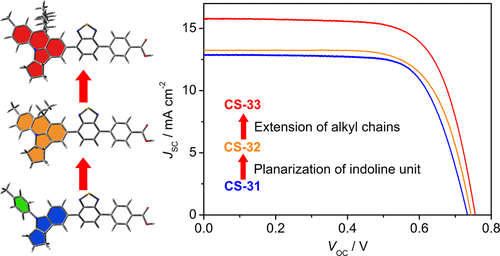当前位置:
X-MOL 学术
›
ACS Appl. Energy Mater.
›
论文详情
Our official English website, www.x-mol.net, welcomes your feedback! (Note: you will need to create a separate account there.)
Molecular Engineering of Indoline Dyes and Their Application in Dye-Sensitized Solar Cells: Effect of Planarity and Side Chain on Interfacial Charge-Transfer Processes
ACS Applied Energy Materials ( IF 6.4 ) Pub Date : 2020-12-28 , DOI: 10.1021/acsaem.0c02199 Lu Tian 1 , Yajun Wang 1 , Yushuang Zhang 2 , Xiaoyan Li 1 , Wenjun Wu 2 , Bo Liu 1
ACS Applied Energy Materials ( IF 6.4 ) Pub Date : 2020-12-28 , DOI: 10.1021/acsaem.0c02199 Lu Tian 1 , Yajun Wang 1 , Yushuang Zhang 2 , Xiaoyan Li 1 , Wenjun Wu 2 , Bo Liu 1
Affiliation

|
Interfacial charge-transfer is the critical process during the operation of dye-sensitized solar cells, determining the photovoltaic performance of the cell. Interfacial charge-transfer processes are affected by many factors, such as the energy level and side chain. According to our previous work, the planarization of the carbazole segment can significantly improve the interfacial charge-transfer performance. However, whether the planarization strategy is universally effective in various dye systems is still uncertain. Moreover, the planarization of the molecule also leads to unfavorable π-aggregation. Thus, herein, the planarization strategy is further applied on indoline dyes while the alkyl chain is also introduced to investigate the effect of the above two factors on interfacial charge-transfer processes. With the improvement of the planarity and the introduction of an alkyl chain, interfacial charge-transfer processes, including charge injection, dye regeneration, and charge recombination, are efficiently optimized, suggesting a certain universality of our planarization strategy. It is noteworthy that the overlong alkyl chain still negatively affects these processes. Accordingly, the improvement of donor planarity as well as the introduction of a suitable alkyl chain can finely optimize interfacial charge-transfer processes, providing a promising strategy for the development of an efficient organic sensitizer.
中文翻译:

吲哚啉染料的分子工程及其在染料敏化太阳能电池中的应用:平面度和侧链对界面电荷转移过程的影响
界面电荷转移是染料敏化太阳能电池运行过程中的关键过程,它决定了电池的光伏性能。界面电荷转移过程受许多因素影响,例如能级和侧链。根据我们以前的工作,咔唑链段的平面化可以显着提高界面电荷转移性能。然而,平坦化策略在各种染料体系中是否普遍有效仍是不确定的。此外,分子的平面化还导致不利的π聚集。因此,本文中,将平面化策略进一步应用于二氢吲哚染料,同时还引入烷基链以研究上述两个因素对界面电荷转移过程的影响。随着平面度的提高和烷基链的引入,包括电荷注入,染料再生和电荷重组在内的界面电荷转移过程得到了有效的优化,这表明我们的平面化策略具有一定的普遍性。值得注意的是,超长烷基链仍然对这些过程产生负面影响。因此,改善供体平面度以及引入合适的烷基链可以精细地优化界面电荷转移过程,为开发有效的有机敏化剂提供了有希望的策略。值得注意的是,超长烷基链仍然对这些过程产生负面影响。因此,改善供体平面度以及引入合适的烷基链可以精细地优化界面电荷转移过程,为开发有效的有机敏化剂提供了有希望的策略。值得注意的是,超长烷基链仍然对这些过程产生负面影响。因此,改善供体平面度以及引入合适的烷基链可以精细地优化界面电荷转移过程,为开发有效的有机敏化剂提供了有希望的策略。
更新日期:2021-01-25
中文翻译:

吲哚啉染料的分子工程及其在染料敏化太阳能电池中的应用:平面度和侧链对界面电荷转移过程的影响
界面电荷转移是染料敏化太阳能电池运行过程中的关键过程,它决定了电池的光伏性能。界面电荷转移过程受许多因素影响,例如能级和侧链。根据我们以前的工作,咔唑链段的平面化可以显着提高界面电荷转移性能。然而,平坦化策略在各种染料体系中是否普遍有效仍是不确定的。此外,分子的平面化还导致不利的π聚集。因此,本文中,将平面化策略进一步应用于二氢吲哚染料,同时还引入烷基链以研究上述两个因素对界面电荷转移过程的影响。随着平面度的提高和烷基链的引入,包括电荷注入,染料再生和电荷重组在内的界面电荷转移过程得到了有效的优化,这表明我们的平面化策略具有一定的普遍性。值得注意的是,超长烷基链仍然对这些过程产生负面影响。因此,改善供体平面度以及引入合适的烷基链可以精细地优化界面电荷转移过程,为开发有效的有机敏化剂提供了有希望的策略。值得注意的是,超长烷基链仍然对这些过程产生负面影响。因此,改善供体平面度以及引入合适的烷基链可以精细地优化界面电荷转移过程,为开发有效的有机敏化剂提供了有希望的策略。值得注意的是,超长烷基链仍然对这些过程产生负面影响。因此,改善供体平面度以及引入合适的烷基链可以精细地优化界面电荷转移过程,为开发有效的有机敏化剂提供了有希望的策略。



























 京公网安备 11010802027423号
京公网安备 11010802027423号